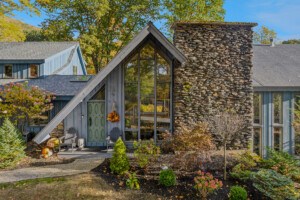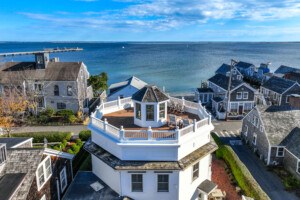10 Questions with Landscape Designer Amy Van Doren

Photo by Gaele McCully.
Amy Van Doren manages the Landscape Design Department at Mahoney’s Garden Centers. With eight locations in the area, Mahoney’s offers the support you need—from in-house designers to helpful seminars—to make outdoor projects approachable for everyone. (Bonus for city dwellers: the Brighton location is very much geared toward the urban gardener.)
Below, Van Doren talks about her own garden, shares her approach to projects, and provides helpful tips for the budding gardener.
1. What do you see as the difference between a landscape and a garden?
To me, a garden is a very emotional and personal space. It’s something that you put plants in and do certain things in because they just make you feel good. A landscape can, on the other hand, do one of two things: provide basic structure and bones to have a garden…or, from beginning to end, be very structured so that it has a “look” depending on the individual space and orientation, style, and architecture of the project.
2. What does your own garden look like?
My garden is not a landscape; my garden is a garden. It’s an all-urban garden. I don’t have a lawn, but I have a keystone patio edged in cobblestone with planting beds all around. I experiment; my garden is rarely beautiful in the classic sense so it’s always full of surprises. … There are things in my garden that I love and will have always, and then there are things that change with my closet.
3. How does having an MBA translate into your work in landscape design?
One of the determining factors of being an MBA is a pragmatism and being able to take the global and make it particular. That set of skills is very helpful, especially in landscape design. I’ve learned about characteristics of all of these different plant materials. I’ve learned what happens in shade, next to highways, at the beach. Then, I can take those individual situations and apply all those principles and make it pragmatic and creative. So I think it’s that kind of thinking process that an MBA trains you to do that is helpful and applicable here.
4. What sort of writing and speaking engagements do you do?
Typically, I do them for community groups, adult ed, or seminars that we do here at Mahoney. There are a couple different topics that are near and dear to my heart, including basic housekeeping of the garden; pruning; shade gardening; and low-maintenance landscaping.
5. What’s your approach to starting a project?
It’s both design and education. People come in for a relatively brief experience with us and walk away with the resources and the knowledge that they need in order to ask the right questions along the way and have some success in their garden.
As for the logistics: [clients] tell us the 30-second rundown of their project. We figure out among our services the best way to help them and set up an appointment. They either collect a lot of information or we go collect a lot of information about their situation. [At the appointment,] they sit down with a designer and we start working to create an end product, which is a roadmap for them to more forward.
Part of that map is they go out into the nursery, perennial yard, and the garden shop and work with salespeople to fill in the blanks. They collect the plant materials that they need, or the fountains, or the planters, and then we work with delivery, and in some cases, installation.
6. What sort of information do you collect?
A prop plan, or different measurement—people come in for what we call our “in-store design” and they’ve typically measured the spaces that will be redesigned into the landscape, and also bring tons of photographs. We lay it all out and do a series of interviews to figure out what’s going on in their imagination and also what’s going on in their property.
In general, we don’t do soil samples, but there are situations in which we recommend them. We can usually tell what’s going to do well from what’s growing there now and what the conditions are. Is the grass growing well? Is there a lot of moss? How many big trees are there? Do you see rocks in these pictures? Is it sandy? All of those kinds of conditions…give us the clues we need to recommend plants that can do well.
7. How do you go about designing for an urban landscape?
In an urban landscape there is a lot typically going on. There are neighbors, fences, sometimes there are very large trees, so all of this is at work before you even start to think about your garden. … Given that it’s small, it also means that every little bit of space counts. One of the things that I’ve recently become a big proponent of is creating a canopy, [which] is a really effective way to deal with some of the distractions that are going on in an urban landscape. If you can create something that issues three dimensions in, say, a patio in an urban setting, then you have all of that space above—six to eight feet—that’s also part of your landscape. The other thing to think about is incorporating things that don’t grow. Water features are really terrific in a space like that.
8. What changes when you are designing for a suburban landscape?
Often, it’s dictated to a certain extent by how people play or how they want to use that yard. … Those components are always the first thing we take into consideration. The space doesn’t necessarily get treated as one yard; it could be treated as three yards, conceptually speaking. For example, the patio yard, the playing yard, the animal yard, so that all of those things aren’t segregated but create a different sense of space in different parts of the yard.
9. What tips can you share for maintaining a healthy landscape or garden?
The first thing is good housekeeping—keeping things appropriately cleaned up, so that there’s not a lot of dead material around plants for fungus, bacteria and bugs to get in; secondly, keeping things appropriately watered and for trees, shrubs, and perennials that means watering them at the roots so that the foliage doesn’t get as wet, and the roots get the water that they need to feed the plant; and finally, airflow around plants is also a good thing. Make sure that if plants are in an enclosed space they are not planted right up against the foundation or they are not planted right up against the fence.
10. What sustainability practices do you encourage your clients to use?
First off, virtually everyone is looking for a low-maintenance landscape. A low-maintenance landscape is well adapted to the landscape in which it is situated. Plants can do well if they are put in an appropriate environment.
The next step is that all plants need watering and care to get themselves established in the first year to year-and-half. By then, if the plants are appropriate for the space…they will have root systems and, except in the most extreme conditions, can take care of themselves [with] minimal maintenance.
Sometimes, it means taking an area of the landscape and making it not a planted area because some environments, like environments under big shade trees are not conducive to plants. In those cases, you’re fighting nature, and I’m not a big fan of that concept.
Contact Amy Van Doren for landscape design projects or attend her seminars. Mahoney’s Garden Centers, Brighton, Chelmsford, Concord, East Falmouth, Osterville, Tewksbury, Wayland, and Winchester. Info: mahoneysgarden.com.
This interview has been edited and condensed.
Our Faves from Amy Van Doren's Designs for Mahoney's Garden Centers












